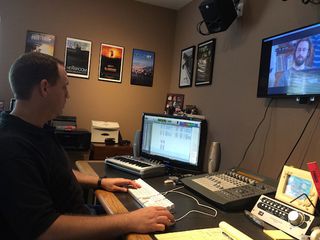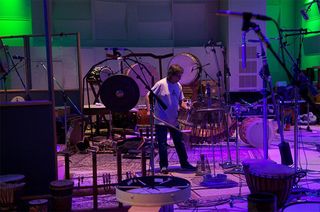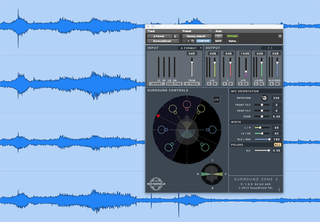Create convincing soundscapes for your next AV project
Pro audio tools have entered the cloud, becoming more affordable for creatives as a result.
If you're working in the creative realm, you're likely well aware of how important a role sound plays in any multimedia project. The first thing that comes to mind is, of course, the music or the score that accompanies the visuals in films, trailers, games, corporate AV presentations, and so on. Less obvious but just as vital are sound effects and consequently, the sound design of a production.
Music, dialogue/voice, and sound effects together make up the 'soundscape', the aural equivalent to a landscape or the place where the story takes place, the space surrounding the story. If you picture a movie scene or a video game scene, or even just a dream, your mind simultaneously and automatically pictures, or rather hears, the sounds that belong to that scene.
Imagine a scene of a dog running through a fall forest – you hear the rustling of leaves in your head, don't you? But even such a small scene is accompanied by all sorts of sounds, such as the panting of the dog, the pattern and pace of its stride, the wind blowing through the trees, children playing in the background, and more.
It's the sound designer who makes all these elements come together in a way to support the story. Let's take a closer look at the creation of soundscapes and what makes them work.

What's your goal for the scene?
First thing's first: what do you want to achieve with the score for your project? In an interview with Polyglon.com, Brian Schmidt, executive director of the GameSoundCon convention and one of the leading experts in video game music and video game sound design, said that music and audio in games serve a lot of different purposes, some obvious, some not so.
"From a player perspective, music can kind of manipulate you," said Schmidt, who created sound for a number of pinball machines and arcade games including Hook and NARC. "Music can really pull at your strings and get you going in the direction the game designer wants you to get going."
Sound can also be used to inform players, he said. For instance, when a player has a power-up, the audio might change until the power is gone. Or if a player is dying, the audio might change to note that. "You can both play with the emotions of a player in a subtle way and also directly inform them about what's going on," he said.
Get the Creative Bloq Newsletter
Daily design news, reviews, how-tos and more, as picked by the editors.
The tools for scoring
Just a few short decades ago, it was an enormous task to produce a convincing, professional-sounding soundtrack for a film, TV show, or any multimedia project. A room full of live musicians or a whole orchestra, recorded in a professional studio, was the norm. This required a lot of time and big budgets.
Today, convincing scores can be written and performed by one person using virtual instruments and a plethora of desktop music creation tools. Many of these software tools are of such high quality that, in context, the average person cannot tell whether they're listening to an orchestra playing or to a score composed on a computer.
We spoke to EastWest Sounds, the market leader of virtual instruments for over 25 years. The company also owns a legendary recording studio complex in Hollywood, EastWest Studios, where iconic musicians have recorded the most celebrated music of the last 50 years, from Frank Sinatra to The Rolling Stones. These studios have produced more Grammy-winning albums than any other studio in the world and it's here that EastWest records the instruments for its libraries.

To answer the demands for scoring in a growing AV market, EastWest – as the first virtual instrument maker – recently removed the barrier between the hobbyist and the professional by introducing a very affordable subscription model, Composer Cloud, that gives composers access to their enormous catalogue of 9000 instruments and over a million sounds for less than a dollar a day.
"We've seen what's happening," says Doug Rogers, founder and producer of EastWest. "If you can't afford the best instruments, your composition will never sound as good as those from professional composers, and that's a frustrating experience. This is why we decided to offer Composer Cloud at a price anyone can afford. Composer Cloud is a way to level the playing field. Composers can now get the tools the masters use for less than the cost of their daily latte."
Listen to an example of a score produced with only virtual instruments
What about sound effects?
Sound effects are something we're not consciously paying attention to when we experience an AV projects, but they play a huge role and we certainly notice when they are done well. To illustrate just how important sound effects are in a visual production, a leading Hollywood sound designer and mixer Beau Borders, Oscar nominee for Best Sound Mixing and credits such as The Lord of the Rings: The Return of the King, Titanic, Iron Man 3, and more, recently put together the following short video.
As a professional, Beau works with a number of tools to create the effects he needs for his work, and one of the resources he recommends is Pro Sound Effects. For professional sound designers as well as big media production companies like EA, BBC, Red Bull, Google, and many others, Pro Sound Effects offers professional royalty-free sound effects libraries, but just like in the case of EastWest, Douglas Price, the founder of Pro Sound Effects, has seen the company's market widen to now encompass freelancers, independent sound designers and video editors who can't afford sound effects library prices in the tens of thousands of dollars like large production companies can.
To satisfy this end of market, they offer their Hybrid Library at $2500 to applicants who qualify for freelancer pricing and flexible subscription plans to their Online Library starting at $29 a month.

But what really sets Pro Sound Effects apart is their quest for innovation. In July, they launched NYC Ambisonics, a new sound effects library that comes with software from TSL Products allowing users to point 'virtual microphones' in any direction and with a variety of polar patterns for greater control and creativity.
NYC Ambisonics was produced and recorded in 24-bit/96kHz high-resolution using a four-capsule SoundField microphone to capture the ambiences from all angles as separate tracks. The Ambisonics format allows the user to manipulate the tracks in real time to create virtually endless perspectives within a scene.
Creating a powerful soundscape is every bit as important as visuals in a production, and we're seeing new innovations and tools being launched every day to support power of the unseen on screen. For composers and sound designers who are just starting out, the fact that a lot of the professional tools come down-market is a huge advantage. With the unquenchable thirst of the public for online AV content constantly increasing, so do the opportunities for creative work – whether it's in the game/film/TV industry, or on places like YouTube.
Words: Martina McConnon
Martina McConnon has been working in the music production industry all her professional life. She and husband Brian run Music Marcom, a PR agency specialized in music technology, musical instruments, and pro audio. She lives and works in Phoenix, Arizona.
Like this? Read these...
- 5 audio software production tools
- Free graphic design software available to you right now!
- Brilliant Wordpress tutorial selection

Thank you for reading 5 articles this month* Join now for unlimited access
Enjoy your first month for just £1 / $1 / €1
*Read 5 free articles per month without a subscription

Join now for unlimited access
Try first month for just £1 / $1 / €1
The Creative Bloq team is made up of a group of design fans, and has changed and evolved since Creative Bloq began back in 2012. The current website team consists of eight full-time members of staff: Editor Georgia Coggan, Deputy Editor Rosie Hilder, Ecommerce Editor Beren Neale, Senior News Editor Daniel Piper, Editor, Digital Art and 3D Ian Dean, Tech Reviews Editor Erlingur Einarsson and Ecommerce Writer Beth Nicholls and Staff Writer Natalie Fear, as well as a roster of freelancers from around the world. The 3D World and ImagineFX magazine teams also pitch in, ensuring that content from 3D World and ImagineFX is represented on Creative Bloq.
